Because this adult Bald Eagle was under duress it was eating the carp in flight.
- But first, an explanation. Recently several readers requested that I post images from some of my very early blogs. I think it’s a good idea to occasionally do just that because when Feathered Photography launched I had no audience to speak of so few ever saw those images. Most (though not all) of the photos below were published nearly five years ago on February 8, 2011 and for a time thumbnails of some of them were included in the rotating banner at the top of my blog. I’ve reprocessed each of these photos (my processing skills were fairly primitive back then) and these versions have been cropped differently. I’ve also rewritten the text. Each of these images is presented in proper sequence.
The winter of 2011 at Farmington Bay was a madhouse of Bald Eagles and gulls competing over the invasive carp killed by refuge personnel in an effort to control their destructive tendencies. Even Northern Harriers joined in the fray and were eating fish. The dead carp concentrated in small areas of open water (most of the refuge was frozen) so that’s where the scavenging eagles and gulls were found in large numbers.
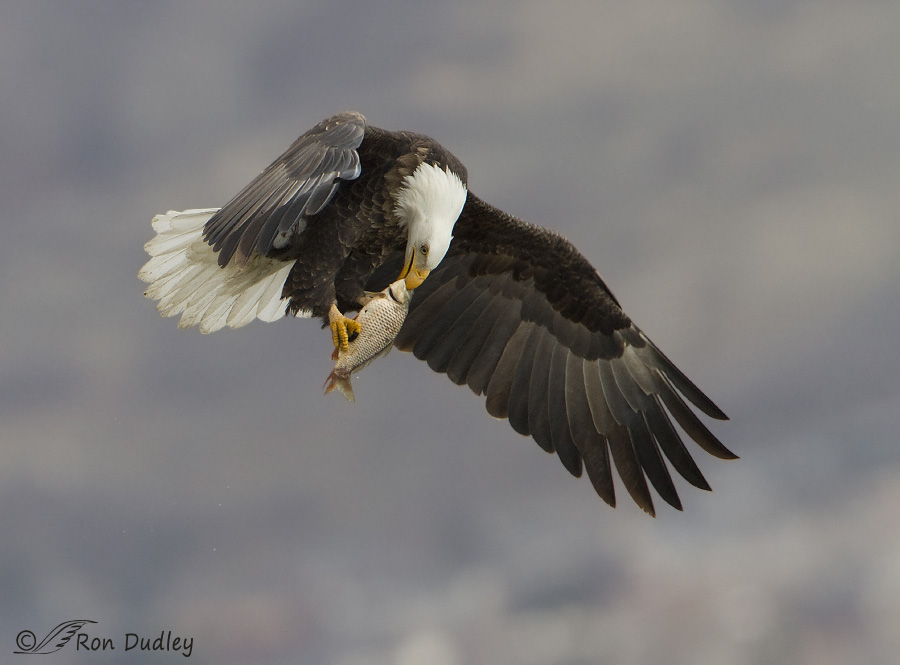
1/1250, f/7.1, ISO 500, Canon 7D, Canon EF 500mm f/4L IS USM + 1.4 tc, not baited, set up or called in
When an eagle claimed a fish on the ice the competition for it was often fierce. Fights regularly broke out between eagles over food and the gulls were constantly pestering eagles for their carp so this one tried a different tack – it took off from the ice and began to eat its fish in flight. As is common with eagles it first went for the eyeball.
I don’t know why Bald Eagles often go for the eye first but it’s something I’ve seen more than once. I’ve read that Golden Eagles often do the same with their mammalian prey. I don’t see how it can be because the eye is particularly delectable or nutritious because the fluid (vitreous humor) that makes up most of its volume is about 98% water. Perhaps it’s an instinctive behavior that prevents the “victim” from seeing so its struggles to get away might be less effective but that’s only a wild guess. I don’t believe that this bite was an attempt to kill the fish because it had already been dead for days. If anyone has some insight into this behavior I’d love to be enlightened.
Ok, back to the story…
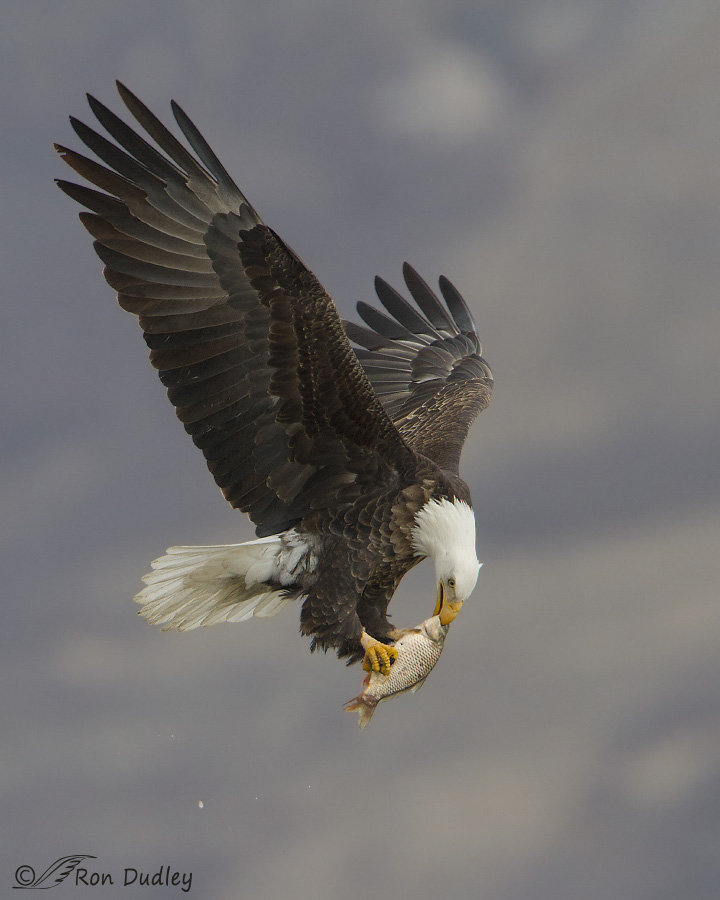
1/1600, f/7.1, ISO 500, Canon 7D, Canon EF 500mm f/4L IS USM + 1.4 tc, not baited, set up or called in
This eagle was a skilled multitasker. It was trying to fly with the extra weight and inconvenience of the fish at the same time it was digging out that eyeball and attempting to avoid other birds in the air, some of whom were after its fish. Here you can see several scales and other debris falling away from the carp.
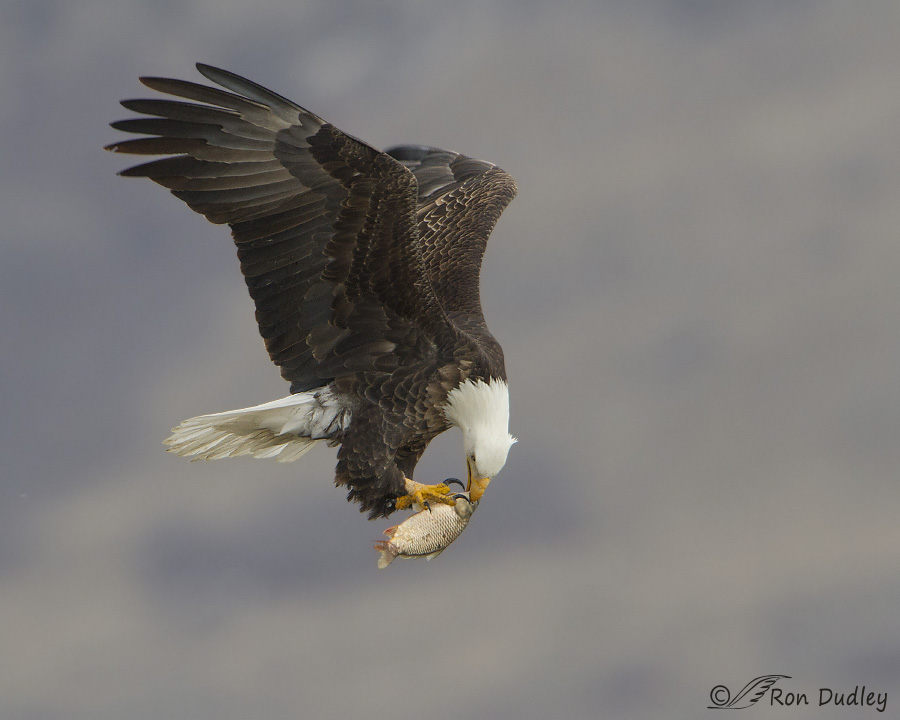
1/1600, f/7.1, ISO 500, Canon 7D, Canon EF 500mm f/4L IS USM + 1.4 tc, not baited, set up or called in
As it attempted to remove the eye the head of the fish was wobbling around which made the task even more difficult so the eagle unclamped its claws from just above the tail of the carp and moved its right foot closer to the head for more stability. This gave me a good look at those formidable talons.
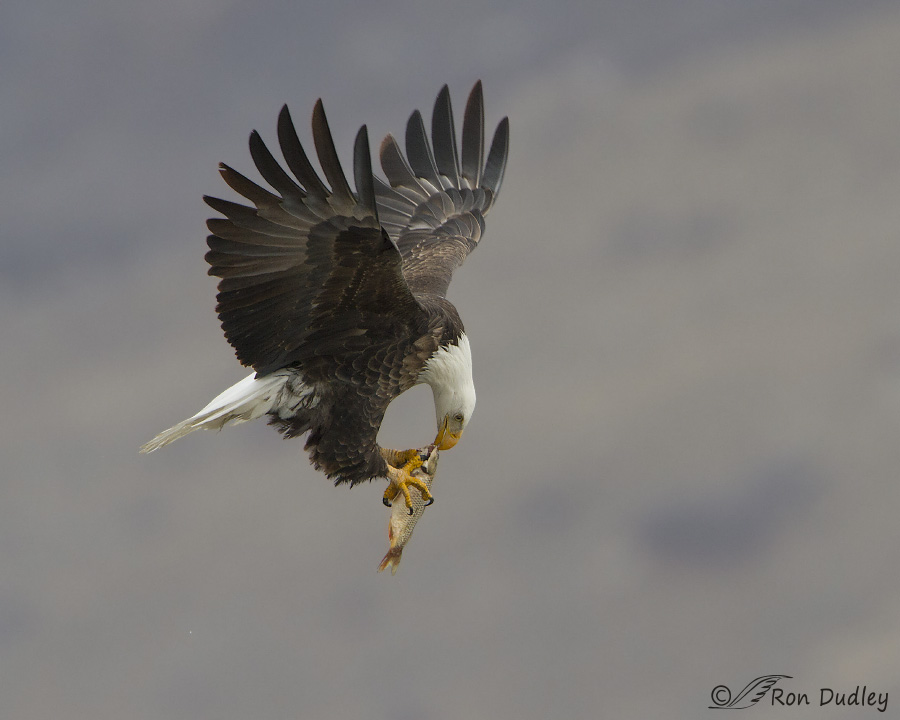
1/1600, f/7.1, ISO 500, Canon 7D, Canon EF 500mm f/4L IS USM + 1.4 tc, not baited, set up or called in
As you can probably tell from its posture the eagle wasn’t flying very fast while it was attempting to do so many things at the same time. That relatively slow flight gave me a great opportunity to fire off several bursts with sharp focus on the action. I remember trying to ration my shots so the buffer of my Canon 7D didn’t fill up so I’m sure I missed some interesting shots that I’d have been able to get using my present 7D Mark II with its faster burst rate and larger buffer. Oh well, I’m not complaining, really I’m not.
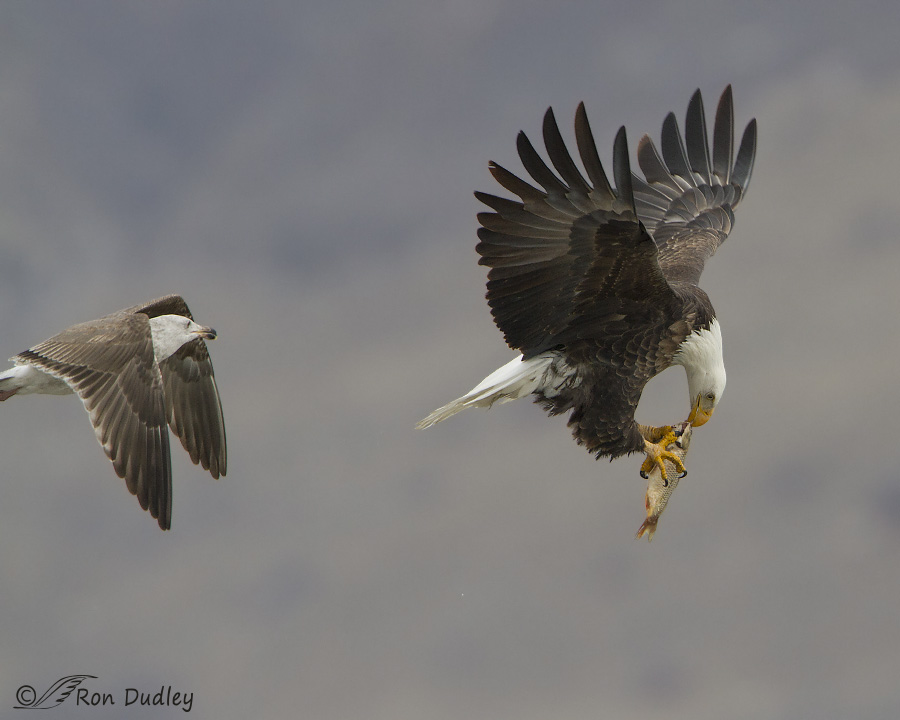
1/1600, f/7.1, ISO 500, Canon 7D, Canon EF 500mm f/4L IS USM + 1.4 tc, not baited, set up or called in
A different crop of the previous image reveals why the eagle felt some urgency to consume the fish. The gulls were absolutely relentless in their efforts to cause an eagle in flight to drop its fish.
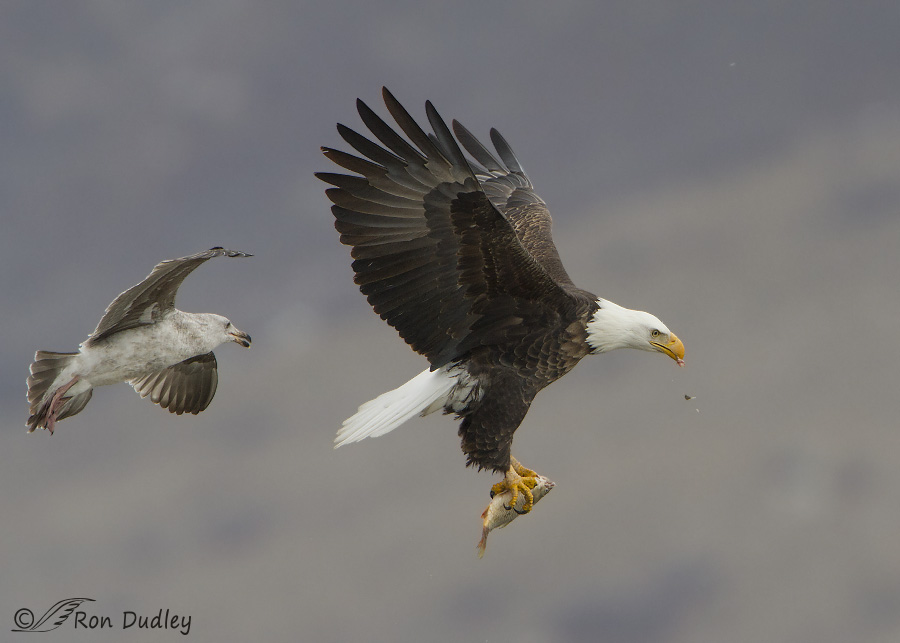
1/1600, f/7.1, ISO 500, Canon 7D, Canon EF 500mm f/4L IS USM + 1.4 tc, not baited, set up or called in
Twice on this morning I actually saw a gull bite the tail of an eagle in flight and one time the gull held on to the tail for a second or more. I don’t recall if this gull bit the eagle’s tail or not but it looks to me like it was thinking about it.
I was very lucky with this sequence for many reasons, among them the fact that on this morning the light angle was far from ideal so if there’d been bright sky in the background the action would have been backlit and image quality compromised. But the eagle was low enough that I got the nearby dark Wasatch Mountains in the background and that made a huge, positive difference.
Our forecast calls for intermittent snow and mostly overcast skies for the foreseeable future so I may not be posting many new images for a while. Thankfully I have extensive archives to fall back on but I’ll try not to overdo the older images…
Ron
PS – There’s another reason I’m glad I went back to look at these images. In doing so I realized that I had only four shots of the series in my photo organizer (the four in the original post) but I knew I’d taken more than that. In searching for the missing images I was able to find 15 more of them. Not all of them are great images but I’m glad to have them if for no other reason than to help fill in the background of the event.


Awesome shots Ron! Thanks for sharing!
Charlotte
Classics.
Ahh, you remember them, Mike. Thanks.
Such a beautiful bird. Great shots. Kind of a eat and run aka fly. It never ceases to amaze me how a smaller bird will try and take on a bigger, and more powerful bird. Such is life I guess.
Thanks very much, Jean.
Ron, I look at your beautiful photos all the time. I don’t make comments, but wanted you to know I really love them. Favorites are Eagles, Bears, Western Meadow Larks, Mountain Blue Birds. Also like Moose. Not sure if you only post birds off hand, but have to mention my favorites. Keep all the pictures coming.
Trudy, I photograph wildlife other than birds when I encounter them but my primary focus is on birds. I’ve posted quite a few coyotes, pronghorn and bison here and the occasional moose, badger, weasel and a few other mammals.
i’ve enjoyed your images for years, and managed to keep my mouth shut. but this time i must say: Wow!
Nice to know you’re “out there”, Jon. Thank you.
Incredible shots!! Ron….thanks again
I’m glad you enjoyed them, Steve. Thanks.
Great shots, Ron, as usual!! There must be something to the eyeballs that we just don’t get. Some countries consider the eyes of a fish to be a great delicacy, and the guest of honor is the one to receive them. Remind me never to be a guest of honor on such an occasion! 🙂
I don’t think you’ll have to be reminded, Jane. I won’t either. Thank you.
I find it particularly arrogant when raptors eat on the fly in the “I can fly, you can’t” category! 😉 Not that I’d begrudge them this skill. It’s just that I’m green with envy that I can’t fly. Heck, I often struggle with walking, so once again, I’m reminded that I’m only human, pasted to the ground forever. Harrumph!
I’ve often watched my birds (who are no more mine than the air I breathe) enjoy eating the eye(s) and the thought I get from them is that eyes squish like grapes (in our world). When I mention that, I usually get the Ewwww response from other humans, but no matter–I’m looking at the situation from the hawk/eagle/falcon/owl perspective. And Dick Harlow has a valid point about allowing easier access to the yummy brain matter, a leverage point for easy opening of the cranium.
I’m pretty sure the gull in the photo is a juvenile, more likely to try to snatch a meal, but any of the adults would play the same game. There’s no point in the eagle turning around to fight it off, because to do that, the eagle would have to drop the fish to free its talons and that ain’t happening. Over the last couple of years, I’ve seen a couple of dozen photos of smaller birds riding on the back of various raptors. I was astounded when a friend of mine captured a shot of a scissor-tailed flycatcher riding the back of her falconry Cooper’s hawk! I had NO idea that kind of thing happened, but I’ve now come to the conclusion that it happens far more frequently in the wild. The hitch here is that it takes someone like you to be out in the field at the right time at the right place with the right equipment and the knowledge to use it along with the ability (sense) to raise said equipment instead of merely staring the sight with a dropped jaw. LOL!
At this point, you should know that I’ve said, “What a spectacular series of shots, Ron” several times and I’m so grateful that you share your photographic talents with us.
I’ll stop rambling now and get ready to take the birds out since it’s a 40-degree day. Sunshine is a little too much to ask for here, but that’s really not necessary (except for MY sanity).
I have the same thoughts and feelings as you about my own lack of flying ability, Laura. Some birds are nothing more than showoffs!
Have you ever actually tried to squish an eyeball like a grape? I have, many times (remember I used to teach zoology, it’s not that I’m a ghoul, necessarily…) and in my experience it simply cannot be done. Vertebrate eyeballs are tough, tough, tough! But of course if I had the sharp beak of a raptor it would likely be much easier.
I’ve actually photographed Brewer’s Blackbirds landing on the backs of Red-tailed Hawks.
https://www.featheredphotography.com/blog/2015/06/18/blackbirds-mobbing-hawks-on-the-nest/
Thank you, as always, for sharing your insight and knowledge.
Yeah, they’re serious showoffs! Grumble 😀
No, I haven’t tried to squish an eyeball, but there’s the issue that my hands don’t have any power to them, unlike the beaks of a redtail and a Harris’ hawk (or other raptors I’ve worked with). So I’d think, but don’t know for sure, that they have a much easier time with the squishing part. Plus, since the birds really like that part, I’d get in trouble if I stole from them! But while they really like the heads/eyes, I’ve watched as Mariah and Jack go directly to the heart, lungs and liver of mammals like rabbits and squirrels with surgical precision most of the time. Both of them go for the head in catching the critter, but once it’s dead, they switch to the bloody goodness in the chest, delighting in drinking the blood.
I’m not a ghoul, either, but when you’re looking at things through the perspective of a raptor, everyday things take on a whole different meaning. And IF it turns out that reincarnation is a thing, in my next life, I want thefeathers AND wings of a raptor (gotta be specific on that request…roaches have wings, too and I do NOT want those kind of wings!). But I’ve digressed, again.
And yes, I figured you’d have a photos like that with the Brewer’s blackbird on the back of a redtail! Since you routinely meet all the criteria I mentioned, that does NOT come as a surprise. BEAUTIFUL!
And now, it’s time to hit the field, hoping we at least score a vole or two…or even several! LOL!
Flying? Oh yes. If only. And at least one of my many selves would like to squish the eyeballs of those who irritate me. And then go for the brains (if I could find them). I can think of a few people I would happily crap on too. If I could spare the time from soaring the skies…
Yay for an archive trawl, and some spectacular images.
Thanks for enjoying the crawl, EC. And for saying so.
Elephant’s Child, you made me laugh out loud…thanks for that! I’m thankful I didn’t have a full mouth at the time…LOL!! And yes, falconry makes you look at stupid, annoying humans in a whole new and exciting way. 😀
I was given H is for Hawk by Helen Macdonald for Christmas which I am really, really looking forward to reading. Have you come across it?
I’ve just finished listening to Helen MacDonald’s narration of this book. I enjoyed it hugely! Probably best to mention that in addition to her psychic journey to wholeness while training her goshawk, it’s a rambling account of grief, dislocation and the tortured life of author T.H. White. Like Robert MacFarlane’s masterful book, The Old Ways, it’s a meditation on the human condition and the wilderness in the most poetic of terms. Hope you like it!
Thank you. I expect to.
I have read it EC, and it’s outrageously wonderful. You’ll learn a lot about falconry (in England, but nonetheless), goshawks, temporary insanity, T.H. White (author of the Arthurian legend, “The Once and Future King”) and his insanity. Helen MacDonald is an outstanding writer. Her prose is simply elegant and she explores the depths of what falconry means in all its glorious whacko delightful craziness. From my perspective, she spent far too much time dissecting T.H. White to the point that it made me throw the book down about halfway through. I picked it up again after I’d come to a point of understanding that T.H. White did the best he could with his first goshawk without any substantive guidance (and he did a MUCH better job with his second that he named Cully (without the ‘e’). She appeared in his book, “The Sword and the Stone.” ANYWAY, back to MacDonald’s book, it’s a fine work of art.
Thank you. And apologies to Ron for highjacking his blog with one of my other obsessions, reading. I knew about T.H White (and have The Once and Future King). And falconry has always struck me as a truly wonderful insanity. Blood, sweat, tears and joy. Along with the heart-ache.
EC, it’s an outrageous insanity. I’m ready to go out with the birds shortly. It’s cold and wet. I don’t really WANT to go out–I’d rather take a nap. HOWEVER, the next couple of days are going to be colder (too cold for the HH and me). So, we’re going out today. Falconry gives you the highest highs and the lowest lows. A friend’s female Cooper’s was just killed by a redtail. Others this year have lost their birds to aspergillosis. It’s been a tough year. And yet, here we go today. I keep trying, but I’m incapable of wrapping words around this insanity. Helen missed it, too, although she came really close! I think it’s impossible to wrap words around this because our language just doesn’t go there.
No apologies necessary here, EC. I’m just sitting back and enjoying the conversation.
Jaw dropping! or should I say Jaw dislocating is how I remember my reaction to image #2 when it was posted on NPN. With good reason I might add. For your readers who may not know, image #2 was the Avian image of the Year on NPN for 2011. A little research found that it has had 7,205 views and 103 comments to date. Linked here: http://www.naturephotographers.net/imagecritique/ic.cgi?a=vp&pr=166462&CGISESSID=e124f6b7a5281fb23904cc389cc179b5&u=3688&title_action= As one of the comments says “You Da Man”. This is the kind of image that pays for a lot of equipment. Or at least it should. It would be the cover of your book (you are not doing) if I was to pick. The series is award winning stunning as well.
“Well Done” is an understatement.
The eye is a pretty easy portal for a tasty morsel. Even on the wing. I’ve witnessed Magpies that discover a non-predated carcass, instinctively start with the eyes. Easy access tidbits as well as starting a scent stream that will draw in other, more powerful scavengers to open up the dinner plate for a more satisfying meal.
Thanks for providing that link, Neil. Ahhh, the memories at NPN!
Your comment about magpies is an interesting one. As much time as I’ve spent with them I don’t think I’ve ever come across them on a carcass early enough to know what they “start” with.
As a kid grown up in Asia, we cook and eat fish in full. I especially like the stomach portion (not the inside) because of high in fat and no bones. Sometimes I ate the eyeballs. Later on I found the bears in Alaska like the fish stomach too. In the days with plenty of fish, they only eat the stomach and discard the rest. The real eyeball is not that edible, but the surrounding area in the socket is soft and high in fat with only one small piece of muscle, those were the parts I was after. Maybe this explain a little about the eagle’s preference.
I have seen crows chased bald eagle away in Alaska, but eating on the fly is a new evidence that bald eagle is not as majestic as I thought. Ha.
An interesting comment, Lisa. I was unaware that the area surrounding the eyeball has a high concentration of fat – that could explain some things.
It was my understanding that when fish are plentiful and bears can be choosy they prefer to eat the fish skin and discard the rest.
Some of your images should be annual events…..
On your birthday…!
Glad you went back in time Ron and did a repost. Amazing images. Talk about multitasking. Being chased, flying, and using both feet and a beak to hold into it’s prey!
It was an amazing demonstration of coordination and other skills from the eagle, Colin. If it had been a juvenile bird I’ll bet it wouldn’t have gone so well…
Hi Ron,
I used to fly a great deal prior to my retirement , and never developed a liking for airline food. This series gives an entire new meaning to in-flight meals – maybe next time the eagle will choose to fly business class in order to have more options…
Excellent series, as always – thanks!
Cheers,
Dick
Thankfully I’ve had very little experience with airline food and I dearly hope that continues. What they served on my recent flight to Florida looked pathetic so I didn’t partake. Thanks, Dick.
Feb.8, 2011 was my birthday…had another one, same day a year later…I remember one of the images, one of my all time favorite eagle images, but others are new to me. I could see them a thousand times and never tire of them…they are classics. I know you also do have one, somewhere, where a gull is biting an eagle’s tail…must be one of this series.. THANKS for giving us another chance to see this wonderful series…and for making it possible for new viewers to see it for the first time…this is one not to be missed…..
Patty, I don’t remember an image of mine that shows a gull actually biting an eagle’s tail but it’s possible that I do have one. I have so many images that it’s very difficult to remember all of them, especially at my age… :).
Happy Early Birthday!
You have one…
Outstanding…one of the very best action sequences ever! That’s a home run for sure.
Thank you, Jerry. And I like your baseball analogy.
Truly a great series of the Eagles. It is facinating to see them flying and eating at the same time. True multi taskers! You are really talented, Ron. And as we know, talent and luck collide in some of these moments when a photographer gets “the shot”. I love your behavior observations, too. What made me fall in love with birds is observing their behavior, then next, their beauty. I always look forward to what you will share next. Thank you, RON.
I agree with you about behaviors, Deborah. If I have to choose between a great image aesthetically or an image that documents interesting behavior I’ll choose the latter almost every time.
Capturing birds in flight is often quite challenging for me, so I really appreciate your series here. I’m assuming you are hand-holding your camera? Since I am a Nikon shooter, I can’t quite visualize your gear in hand, but it’s got to be quite heavy. 500, teleconverter and all.
Carol, Birds in flight are a challenge for any photographer. I took this series from inside my pickup but can’t remember if I was resting the lens on my window “noodle” or actually hand-holding. Probably the latter. Thankfully my new version of this lens is significantly lighter in weight…
OMG, Ron – I don’t have words to describe how unbelievably wonderful this series is!! I’ve learned, over time, that raptors are opportunistic feeders so will steal from each other and other smaller birds and animals. Seeing the gull chasing the eagle I also learned that an eagle will usually ignore smaller birds that either try to steal their food or harass them. I didn’t understand why they didn’t turn around and attack them but learned that the smaller birds are faster and it waste too much of the eagle’s energy to bother with them. I’ve even seen photos and seen videos where a bird like a blue jay or raven will literally sit on their back to harass them!! I’m absolutely loving your archive foraging – the results have given us so much enjoyment. I am sorry though that you are having so many days when you can’t get out!!
It’s obvious that you’ve spent some time watching eagle behavior, Jo Ann – based on my own observations your comments on the subject are spot on. Thank you.
Ron, these are phenomenal images! Fantastic behavior, detail and IMHO, even the lighting is extremely complimentary. It’s thrilling to see these outstanding and unique behavioral poses. Much as I like eagles, there’s plenty of images showing them diving plastered around the ‘net. These are one-of-a-kind. Thanks so much for sharing them!
As for the eyeball consumption, I don’t know the reason or logic. It does remind me a little bit of Osprey behavior though. In my observation of them, it seems those who catch the fish usually eat the head before taking the rest of the fish back to the nest. I haven’t seen them go after the eyes directly, but now you’ve got me wondering…
Thanks again; it was well worth the trip back to archives!
You’re sure right about the Osprey behavior you describe, Kim. That’s what has happened every time I’ve seen one with a fish. I appreciate your kind words about the images and your enthusiasm for my archived photos.
WOW! I’ve never seen that behavior and your certainly caught all the wonderful detail of it. Smiling ear to ear 🙂 Gulls are a pain for eagles, but then the magpies and crows get pretty aggressive from time to time also. Rain/snow/froze over the whole slushy mess – UGH!
You’re right, Judy – lots of birds harass eagles over food. But Bald Eagles do the same to other birds, Ospreys in particular.
That series is unbelievably incredible!! Fantastic capture Ron!!
Thanks very much, Judy.
I don’t know if this is true, but I have heard that removing the eye by an eagle renders easier access to the brain by giving the beak leverage to break through the skull.
Great shots and great behavior images!
Thanks for sharing.
Thanks, Dick. Your theory makes some sense. I hadn’t thought of that possibility.
I agree with Roger!!! Thank you for going back and re-posting. I didn’t know Eagles often went after the eyes first when they had an in-flight snack. Still teaching I see 😉
Zaphir, This was the first and only time I’ve seen an eagle going for the eyeballs first “in-flight”, but I’ve seen them do it several times when they’re on the ground or ice.
Ron, when it comes to “nature photography,” you are among the VERY BEST!!!!! ;-)))
I don’t know about that, Roger, but I sure appreciate the sentiment.
Roger–you are SO RIGHT!!!
WowWowWow Ron! Great shots!
Thanks very much, Nancy.